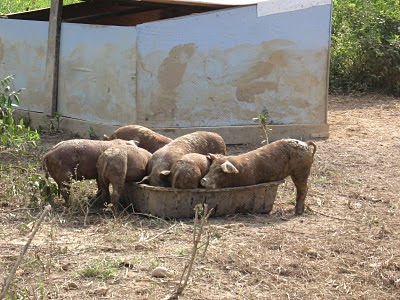Just a few notes from the farm. As you may have noticed, the availability of Ecotone eggs continues to be very low. The hens continue to lay less than a dozen eggs per day,
total. As I've suggested several times, this is primarily due to the heat, both the early and sustained abnormally high temperatures, and the late and continuing days with average highs in the 90's. For each flock, its consequences have been different.
For the year old hens, I think the stress of the heat triggered an early and prolonged molt. While the Rhode Island Reds and Buff Orpingtons seem to have molted almost entirely, the Barred Rocks just appear to be entering the last half. Egg laying naturally tapers off and ceases during molt, and usually lasts about 4-6 weeks. Many industrial egg farms discard hens as soon as they enter their first molt because it's simply more economic to do so. Not only do they not have to feed them for all those days they're not laying eggs, the industrial hybrid hens they use lay upwards of 350 eggs a year, and have at that point just about laid their productive lives away.
For the pullets, I think the heat has caused a different, more complicated effect. To develop normally, growing pullets need a specific protein to fat ratio in the first six months of life. If pullets are either too fat or too skinny when they begin to lay, their metabolism is disrupted such that they'll never really lay to their potential. As I indicated in Egg Count 9, one consequence of the heat is a diminished appetite. In the summer, therefore, the crude protein of the ration should be increased so that they are eating the same
amount of protein even though they are eating less feed overall.
While I learned this interesting bit of ration reasoning a bit late, for most of the hottest part of the summer I did hand-mix cracked, roasted soybeans into their feed to achieve the effect. To determine whether it worked or not, however, we must wait until it cools off. If it did, their delay is a rather superficial problem and should correct itself when average ambient temperatures fall below 85 degrees. If it didn't work, the delay might indicate a more significant problem, which could amount to something akin to a "crop loss" for this season's laying flock. Who knew there could be such a thing in chicken farming?!

In any case, just know that for any day above 90 degrees, it's pretty certain there will be very few eggs. During those few days recently when highs were in the 80s, for example, the hens responded in kind with only a day or two lag in laying. And so as long as such temperatures are in the forecast, I forecast a continuing dearth of eggs. For those who find the craving for eggs insatiable regardless of the season, or for those who receive eggs through the Bells Bend CSA and are approaching the end of the season, there are, then, a couple of options.
First, and above all, if you have an Endless Egg Basket account with us (i.e., if you've paid for a certain number of dozen ahead of time), and would like to begin to get eggs from another source, please know that at any point I am more than happy to refund the balance on your account in full. If you'd like a refund, or just to know the status of your account, please just drop me an email. Second, of course, is the grocery store. Might I recommend a new local food shop on 12th Ave South I recently discovered,
Greenlight Market and Deli, which has local pastured eggs of roughly the same quality for sale. Finally, if you're a member of the Bells Bend CSA and would like to continue receiving eggs beyond the end of the vegetable season, know that there will be several similar drop-offs or delivery routes for the winter months.
To all those loyal Ecotone egg eaters out there, thanks for your patience and concern for the hens' well-being! To all those folks who are on the waiting list for regular eggs, thanks for your continuing interest in Ecotone eggs! While I apologize for misjudging the number of eggs that were going to be available this summer, I don't think I could have anticipated such temperatures into the third week of September! But there is one thing on which I'll venture a forecast: when the leaves begin to fall in earnest, the eggs will again begin to roll.
 The daily average for the month of December, then, was 11.39 dozen per day, or 136.66 eggs per day, which is a monthly rate of lay approaching 44% -- not bad for heritage breed hens!
The daily average for the month of December, then, was 11.39 dozen per day, or 136.66 eggs per day, which is a monthly rate of lay approaching 44% -- not bad for heritage breed hens!



















































